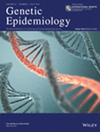Genetic Epidemiology is a peer-reviewed journal for discussion of research on the genetic causes of the distribution of human traits in families and populations. Emphasis is placed on the relative contribution of genetic and environmental factors to human disease as revealed by genetic, epidemiological, and biologic investigations.Genetic Epidemiology primarily publishes papers in statistical genetics, a research field that is primarily concerned with development of statistical, bioinformatical, and computational models for analyzing genetic data. Incorporation of underlying biology and population genetics into conceptual models is favored. The Journal seeks original articles comprising either applied research or innovative statistical, mathematical, computational, or genomic methodologies that advance studies in genetic epidemiology. Other types of reports are encouraged, such as letters to the editor, topic reviews, and perspectives from other fields of research that will likely enrich the field of genetic epidemiology.
《遗传流行病学》是一本同行评审期刊,讨论人类特征在家庭和人群中分布的遗传原因。遗传流行病学主要发表统计遗传学方面的论文,这是一个研究领域,主要关注发展统计学、生物信息学和计算模型来分析遗传数据。将基础生物学和群体遗传学纳入概念模型是有利的。该杂志寻求原创文章,包括应用研究或创新的统计,数学,计算,或基因组学方法,推进遗传流行病学的研究。鼓励其他类型的报告,如给编辑的信、主题评论和来自其他研究领域的观点,这些可能会丰富遗传流行病学领域。
Generalizing polygenic risk scores from Europeans to Hispanics/Latinos
来源期刊:Genetic EpidemiologyDOI:10.1002/gepi.22166
The eMERGE genotype set of 83,717 subjects imputed to ~40\u2009million variants genome wide and association with the herpes zoster medical record phenotype
来源期刊:Genetic EpidemiologyDOI:10.1002/gepi.22167
Loss of function, missense, and intronic variants in NOTCH1 confer different risks for left ventricular outflow tract obstructive heart defects in two European cohorts
来源期刊:Genetic EpidemiologyDOI:10.1002/gepi.22176
Constrained instruments and their application to Mendelian randomization with pleiotropy
来源期刊:Genetic EpidemiologyDOI:10.1002/gepi.22184
Genetic overlap between autoimmune diseases and non‐Hodgkin lymphoma subtypes
来源期刊:Genetic EpidemiologyDOI:10.1002/gepi.22242
Ordered multinomial regression for genetic association analysis of ordinal phenotypes at Biobank scale
来源期刊:Genetic EpidemiologyDOI:10.1002/gepi.22276
Spinning convincing stories for both true and false association signals
来源期刊:Genetic EpidemiologyDOI:10.1002/gepi.22189
ComPaSS‐GWAS: A method to reduce type I error in genome‐wide association studies when replication data are not available
来源期刊:Genetic EpidemiologyDOI:10.1002/gepi.22168
An adaptive test for meta‐analysis of rare variant association studies
来源期刊:Genetic EpidemiologyDOI:10.1002/gepi.22273
Using GWAS top hits to inform priors in Bayesian fine‐mapping association studies
来源期刊:Genetic EpidemiologyDOI:10.1002/gepi.22212
Bayesian variable selection using partially observed categorical prior information in fine‐mapping association studies
来源期刊:Genetic EpidemiologyDOI:10.1002/gepi.22213
Using Bayes model averaging to leverage both gene main effects and G\u2009×\u2009\nE interactions to identify genomic regions in genome‐wide association studies
来源期刊:Genetic EpidemiologyDOI:10.1002/gepi.22171
Summary statistic analyses can mistake confounding bias for heritability
来源期刊:Genetic EpidemiologyDOI:10.1002/gepi.22259
Rare variant association testing for multicategory phenotype
来源期刊:Genetic EpidemiologyDOI:10.1002/gepi.22210
A comparison of popular TDT‐generalizations for family‐based association analysis
来源期刊:Genetic EpidemiologyDOI:10.1002/gepi.22181
Gene–environment interactions related to blood pressure traits in two community‐based Korean cohorts
来源期刊:Genetic EpidemiologyDOI:10.1002/gepi.22195
A novel association of rs13334070 in the RPGRIP1L gene with adiposity factors discovered by joint linkage and linkage disequilibrium analysis in Iranian pedigrees: Tehran Cardiometabolic Genetic Study (TCGS)
来源期刊:Genetic EpidemiologyDOI:10.1002/gepi.22179
Correlations between relatives: From Mendelian theory to complete genome sequence
来源期刊:Genetic EpidemiologyDOI:10.1002/gepi.22206
PAMAM: Power analysis in multiancestry admixture mapping
来源期刊:Genetic EpidemiologyDOI:10.1002/gepi.22216
System for Quality‐Assured Data Analysis: Flexible, reproducible scientific workflows
来源期刊:Genetic EpidemiologyDOI:10.1002/gepi.22178
Heritability analysis of nontraditional glycemic biomarkers in the Atherosclerosis Risk in Communities Study
来源期刊:Genetic EpidemiologyDOI:10.1002/gepi.22243
Population genetic simulation study of power in association testing across genetic architectures and study designs
来源期刊:Genetic EpidemiologyDOI:10.1002/gepi.22264
Powerful statistical method to detect disease‐associated genes using publicly available genome‐wide association studies summary data
来源期刊:Genetic EpidemiologyDOI:10.1002/gepi.22251
Extended methods for gene–environment‐wide interaction scans in studies of admixed individuals with varying degrees of relationships
来源期刊:Genetic EpidemiologyDOI:10.1002/gepi.22196
Effect of population stratification on SNP‐by‐environment interaction
来源期刊:Genetic EpidemiologyDOI:10.1002/gepi.22250
Exome chip‐driven association study of lipidemia in >14,000 Koreans and evaluation of genetic effect on identified variants between different ethnic groups
来源期刊:Genetic EpidemiologyDOI:10.1002/gepi.22208
Estimation of DNA contamination and its sources in genotyped samples
来源期刊:Genetic EpidemiologyDOI:10.1002/gepi.22257
Exact variance component tests for longitudinal microbiome studies
来源期刊:Genetic EpidemiologyDOI:10.1002/gepi.22185
Powerful rare variant association testing in a copula‐based joint analysis of multiple phenotypes
来源期刊:Genetic EpidemiologyDOI:10.1002/gepi.22265
Assessing potential shared genetic aetiology between body mass index and sleep duration in 142,209 individuals
来源期刊:Genetic EpidemiologyDOI:10.1002/gepi.22174
Analytical strategies to include the X‐chromosome in variance heterogeneity analyses: Evidence for trait‐specific polygenic variance structure
来源期刊:Genetic EpidemiologyDOI:10.1002/gepi.22247
Some statistical consideration in transcriptome‐wide association studies
来源期刊:Genetic EpidemiologyDOI:10.1002/gepi.22274
Presidential address: Six open questions to genetic epidemiologists
来源期刊:Genetic EpidemiologyDOI:10.1002/gepi.22191
Beyond the traditional simulation design for evaluating type 1 error control: From the “theoretical” null to “empirical” null
来源期刊:Genetic EpidemiologyDOI:10.1002/gepi.22172
A comparison of two workflows for regulome and transcriptome‐based prioritization of genetic variants associated with myocardial mass
来源期刊:Genetic EpidemiologyDOI:10.1002/gepi.22215
Transethnic meta‐analysis of metabolic syndrome in a multiethnic study
来源期刊:Genetic EpidemiologyDOI:10.1002/gepi.22267
Familial recurrence risk with varying amount of family history
来源期刊:Genetic EpidemiologyDOI:10.1002/gepi.22193
Multi‐ethnic analysis shows genetic risk and environmental predictors interact to influence 25(OH)D concentration and optimal vitamin D intake
来源期刊:Genetic EpidemiologyDOI:10.1002/gepi.22272
Joint analysis of multiple phenotypes using a clustering linear combination method based on hierarchical clustering
来源期刊:Genetic EpidemiologyDOI:10.1002/gepi.22263
Case‐control versus case‐only estimates of gene‐environment interactions with common and misclassified clinical diagnosis
来源期刊:Genetic EpidemiologyDOI:10.1002/gepi.22266
Critical evaluation of copy number variant calling methods using DNA methylation
来源期刊:Genetic EpidemiologyDOI:10.1002/gepi.22269
Leveraging cell‐specific differentially methylated regions to identify leukocyte infiltration in adipose tissue
来源期刊:Genetic EpidemiologyDOI:10.1002/gepi.22252
Meta‐MultiSKAT: Multiple phenotype meta‐analysis for region‐based association test
来源期刊:Genetic EpidemiologyDOI:10.1002/gepi.22248
Modelling RNA‐Seq data with a zero‐inflated mixture Poisson linear model
来源期刊:Genetic EpidemiologyDOI:10.1002/gepi.22246
A simple approximation to the bias of gene–environment interactions in case–control studies with silent disease
来源期刊:Genetic EpidemiologyDOI:10.1002/gepi.22186
Population‐wide copy number variation calling using variant call format files from 6,898 individuals
来源期刊:Genetic EpidemiologyDOI:10.1002/gepi.22260
Assessing pleiotropy and mediation in genetic loci associated with chronic obstructive pulmonary disease
来源期刊:Genetic EpidemiologyDOI:10.1002/gepi.22192
An efficient integrative resampling method for gene–trait association analysis
来源期刊:Genetic EpidemiologyDOI:10.1002/gepi.22271
iFunMed: Integrative functional mediation analysis of GWAS and eQTL studies
来源期刊:Genetic EpidemiologyDOI:10.1002/gepi.22217
Combining sequence data from multiple studies: Impact of analysis strategies on rare variant calling and association results
来源期刊:Genetic EpidemiologyDOI:10.1002/gepi.22261




